The Fernmeldeturm Nürnberg, the tallest structure in Bavaria, is a telecommunication tower in Nuremberg, southern Germany. Also called the Nürnberger Ei because of its egg-shaped tower basket in a height of 185 metres, it is 292 metres high and was built between 1977 and 1980 according to blueprints by architect Erwin Heinle.
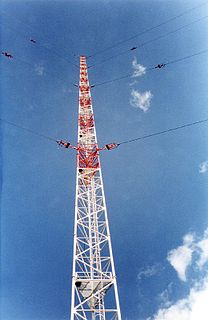
The Roumoules transmitter is the main broadcasting facility for longwave and mediumwave broadcasting of Radio Monte Carlo near Roumoules, France and is owned by Monaco Media Diffusion. The 1000 and 2000kW transmitters installed are among the most powerful in the world and can be received well at nighttime throughout Europe.

The Mühlacker Broadcasting Transmission Facility is a radio transmission facility near Mühlacker, Germany, first put into service on November 21, 1930. It uses two guyed steel tube masts as aerials and one guyed steel framework mast, which are insulated against ground. It has two transmission aerials for shortwave and one free standing steel framework tower for directional radio services. The shortwave transmitter was shut off on October 19, 2004. The medium wave transmitter was switched off in January 2012.

The AM transmitter in Burg, near Magdeburg, Germany, is a huge facility for longwave and mediumwave broadcasting. Its most dominant constructions are a 324-metre guyed radio mast and two 210 metre guyed steel tube masts.

The Langenberg transmission tower is a broadcasting station that transmits MW, FM and TV signals. It is located in Langenberg, Velbert, Germany and has had a very turbulent history since its inauguration. The transmitter first went into service in 1927 with 60 kilowatts (kW) of power and a T-aerial hanging on two 100-metre freestanding steel-frame towers insulated against ground.
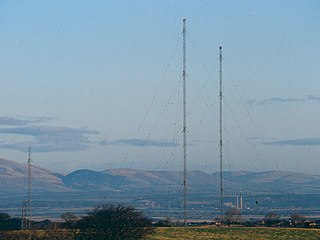
The Westerglen transmitting station is a facility for longwave and mediumwave broadcasting established in 1932 at Westerglen Farm, 2 miles (3 km) south west of Falkirk, Stirlingshire, Scotland.
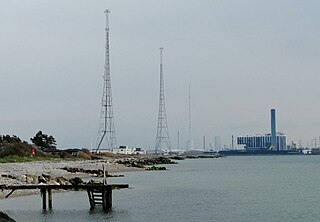
Kalundborg Radio is a major transmission facility for long- and mediumwave at the harbour of Kalundborg in Denmark.
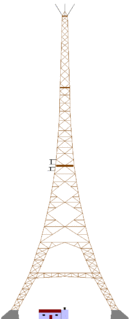
The Transmitter Ismaning was a large radio transmitting station near Ismaning, Bavaria, Germany. It was inaugurated in 1932. From 1932 to 1934 this transmitter used a T-antenna as transmitting antenna, which was spun between two 115-metre-high free-standing wooden lattice towers, which were 240 metres apart. As this antenna had an unfavourable vertical radiation pattern, which produced much skywave resulting in a too small fading-free reception area at night, in 1934 a new antenna was installed. Therefore, one of the towers was dismantled and rebuilt on a 39-metre-high (128 ft) wooden lattice base. While this work took place, an L-Antenna was used, which was spun between the other tower and a small auxiliary wooden tower. It became defunct in 1977 and was destroyed in 1983.
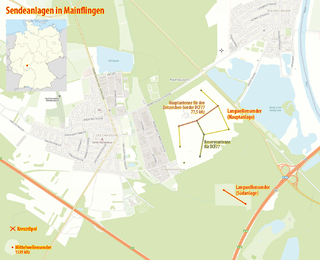
The Mainflingen mediumwave transmitter is a mediumwave transmission facility south of the A3 motorway near Mainflingen, Hesse, Germany. Mainflingen was the first mediumwave transmitter for the radio station Deutschlandfunk. It went into service in 1962 with a transmission power of 50 kW, on a frequency of 1538 kHz, at the upper end of the mediumwave band. This frequency has a bad groundwave propagation and therefore a low range at daytime, but an excellent skywave propagation with a long range at night.

The Mediumwave transmitter Lopik was a medium wave broadcasting facility near Lopik in the Netherlands. It was constructed in 1938 and closed down on 1 September 2015. Its last use was to transmit the Dutch language edition of Radio Maria on 675 kHz. The aerial consisted of a 196-metre guyed steel framework mast, which was insulated against ground.
The mediumwave transmitter Flevoland was a broadcasting facility for medium wave near Zeewolde in the province of Flevoland, Netherlands, situated at 5°25′ E and 52°23′ N. It has been used for broadcasting on 747 kHz and 1008 kHz with a nominal power of 400 kilowatts. As aerial two guyed steel framework masts with a height of 195 metres are used, which form an anti-fading aerial. These masts are grounded and carry a cage aerial, which is upperward the separation insulator, separating the masts in a height of 95 metres in two parts, connected toward the mast construction. The radiation diagram is directional, with a maximum gain of 4 dB in South-Eastern direction, to compensate for the variation in electrical admittance of terrain in the Netherlands.

The Wavre radio transmitter is a facility for mediumwave, shortwave, FM and TV broadcasting near Wavre in Belgium. For the mediumwave transmissions it uses a grounded 250-metre-high guyed mast. Furthermore, there is a backup mast for medium wave transmissions, which is 90 metres high. For shortwave broadcasting several directional antennas and a curtain antenna are used. The towers are two of the tallest structures in Belgium.
The Transmitter Nuremberg-Kleinreuth was a broadcasting facility for medium wave at Nuremberg, Bavaria, Germany. It was founded in 1927 in Nuremberg-Kleinreuth at the former Broadcast Street 24, now Sigmund Street 181, in order to supply the northern areas of Bavaria with broadcast programs in the medium-wave band.

The Topolná transmitter is the central longwave broadcasting facility of the Czech Republic situated west of the village of Topolná on the Morava River.

The Wiederau transmitter is the oldest broadcasting facility in Saxony. It is located near Wiederau, a village which is part of the municipality of Pegau, and is used for medium-wave, FM and Television broadcasting.
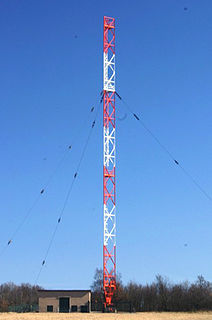
Marnach transmitter was a broadcasting facility of RTL near Marnach in the commune of Munshausen, in northern Luxembourg. The Marnach transmitter was built in 1955 for improving the transmission of the English-speaking program on 1439 kHz, which was transmitted from 1951 with an omnidirectional antenna from Junglinster, to the British Isles and for a better transmission on this frequency to Germany at daytime. Therefore, it was given a directional antenna with a switchable directional characteristic pointing North-northeast towards the Rhine-Ruhr area, Germany's most populated area, and West-northwest in the direction of the UK. This antenna was implemented in form of a directional antenna consisting of three ground-fed 105-metre tall guyed mast antennas arranged in the form of an isosceles triangle with a 90 degree angle. As transmitters, two 100 kW units switched in parallel were used when it went in service in December 1955.

Aholming transmitter was a facility for formerly broadcasting the Program of Deutschlandfunk on 207 kHz with a power of 500 kW at day and 250 kW at night between Aholming and Ottmaring in Bavaria. It was (finally) shut down in the early Morning hours of January 1, 2015. It was demolished in 2018.

Ravensburg-Horgenzell transmitter was a mediumwave broadcasting facility of Deutsche Telekom used for transmitting the program of Deutschlandfunk on the area of community Horgenzell northwest of Ravensburg in Baden-Württemberg. It was inaugurated on August 23, 1951 and used until 1959 for transmitting the radio programme of SWF with a transmission power of 40 kW on 1538 kHz. As antenna, it used a 120 metre tall guyed ground-fed lattice steel mast radiator at 47°47'10" N and 9°31'16" E.

Ehndorf transmitter was a mediumwave radio transmission mast located at Ehndorf, a village west of Neumünster in Schleswig-Holstein, Federal Republic of Germany. Owned by Deutsche Telekom, until 1978 the facility broadcast Deutschlandfunk on 1269 kHz (1268 kHz). It went into service in November 1967 at a power of 600 kW, reduced to 300 kW in 1995. On 31 December 2015 all mediumwave transmissions of the Deutschlandfunk ceased at 2350 CET.

Weiskirchen transmitter, is a mediumwave broadcasting tower in Weiskirchen, Germany. It is the property of Hessischer Rundfunk. It was built in 1967


















